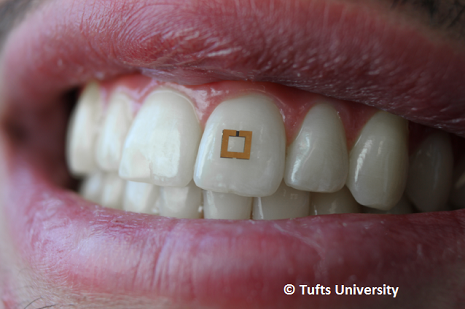Tufts University in Massachusetts Develops Miniature Tooth Sensor to Measures Sugar, Salt, and Alcohol Intake
Orange County, CA - March 29th, 2018 -
Humans have long sought after an easy way to track their food and beverage intake to help with weight loss and other dietary restrictions. While food journals and health coaches have generally been the popular option, there may finally be an easier, more automatic way to track calorie intake. Researchers at Tufts University School of Engineering in Massachusetts have developed a miniaturized sensor that can be mounted directly on a tooth and can communicate wirelessly with a mobile device to transmit information on glucose, alcohol, and salt intake.
In research published on March 23 in the journal Advanced Materials, the researcher team noted that future adaptations of these sensors could permit the detection and recording of a wide variety of nutrients, chemicals, and physiological states.

Previous wearable devices for monitoring dietary intake were plagued with limitations such as requiring the use of a mouth guard, bulky wiring, or demanding frequent replacement as the sensors rapidly wore out. Tufts engineers set their sights on a more malleable technology and developed a sensor with a microscopic 2mm x 2mm footprint that can flexibly conform and bond to the irregular surface of a tooth. Having been compared to “the way a toll is collected on a highway,” the sensors transmit their data wirelessly in response to incoming radiofrequency signal.
The sensors are made up of three layers stacked on top of one another: a center “bioresponsive” layer that absorbs the nutrients or other chemicals to be detected, and two outer layers containing two square gold rings. Together, the three layers resemble a tiny antenna- collecting and transmitting waves in the radiofrequency field.
Additionally, the sensor can change its “color.” For example, if the central layer interacts with salt or ethanol, the electrical properties shift, causing the sensor to absorb and transmit a different variety of radiofrequency waves with fluctuating force. That is the process in which nutrients and other analytes are detected and measured.
“In theory, we can modify the bioresponsive layer in these sensors to target other chemicals – we are really limited only by our creativity,” said Fiorenzo Omenetto, Ph.D., who is the corresponding author and the Frank C. Doble, Professor of Engineering at Tufts. “We have extended common RFID (radiofrequency ID) technology to a sensor package that can dynamically read and transmit information on its environment, whether it is affixed to a tooth, to the skin, or any other surface.”
Contact Ampronix:

Email: info@ampronix.com
International Sales: +1 949-273-8000
Domestic Sales: 1800-400-7972 for US and Canada
Follow Us:
Share This Article:
View our Product Catalog Online Here
About Ampronix
Ampronix is a renowned authorized master distributor of the medical industry's top brands as well as a world class manufacturer of innovative technology. Since 1982, Ampronix has been dedicated to meeting the growing needs of the medical community with its extensive product knowledge, outstanding service, and state-of-the-art repair facility. Ampronix prides itself on its ability to offer tailored, one-stop solutions at a faster and more cost effective rate than other manufacturers. Ampronix is an ISO & ANSI/ESD certified facility. To learn more go here.

Tufts University in Massachusetts Develops Miniature Tooth Sensor to Measures Sugar, Salt, and Alcohol Intake Orange County, CA – March 29th, 2018 – Humans have long sought after an easy way to track their food and beverage intake to help with weight loss and other dietary restrictions. While food journals and health coaches have generally been […]



